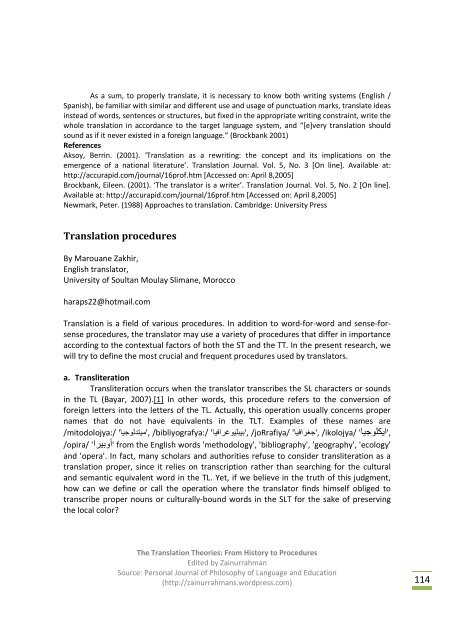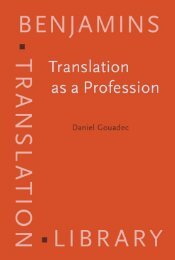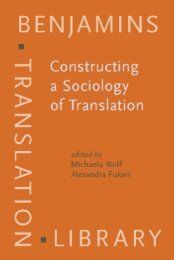Translation Theories.pdf
Translation Theories.pdf
Translation Theories.pdf
Create successful ePaper yourself
Turn your PDF publications into a flip-book with our unique Google optimized e-Paper software.
As a sum, to properly translate, it is necessary to know both writing systems (English /<br />
Spanish), be familiar with similar and different use and usage of punctuation marks, translate ideas<br />
instead of words, sentences or structures, but fixed in the appropriate writing constraint, write the<br />
whole translation in accordance to the target language system, and “[e]very translation should<br />
sound as if it never existed in a foreign language.” (Brockbank 2001)<br />
References<br />
Aksoy, Berrin. (2001). ‘<strong>Translation</strong> as a rewriting: the concept and its implications on the<br />
emergence of a national literature’. <strong>Translation</strong> Journal. Vol. 5, No. 3 [On line]. Available at:<br />
http://accurapid.com/journal/16prof.htm [Accessed on: April 8,2005]<br />
Brockbank, Eileen. (2001). ‘The translator is a writer’. <strong>Translation</strong> Journal. Vol. 5, No. 2 [On line].<br />
Available at: http://accurapid.com/journal/16prof.htm [Accessed on: April 8,2005]<br />
Newmark, Peter. (1988) Approaches to translation. Cambridge: University Press<br />
<strong>Translation</strong> procedures<br />
By Marouane Zakhir,<br />
English translator,<br />
University of Soultan Moulay Slimane, Morocco<br />
haraps22@hotmail.com<br />
<strong>Translation</strong> is a field of various procedures. In addition to word-for-word and sense-forsense<br />
procedures, the translator may use a variety of procedures that differ in importance<br />
according to the contextual factors of both the ST and the TT. In the present research, we<br />
will try to define the most crucial and frequent procedures used by translators.<br />
a. Transliteration<br />
Transliteration occurs when the translator transcribes the SL characters or sounds<br />
in the TL (Bayar, 2007).[1] In other words, this procedure refers to the conversion of<br />
foreign letters into the letters of the TL. Actually, this operation usually concerns proper<br />
names that do not have equivalents in the TLT. Examples of these names are<br />
,'ایكلوجیا' /ikolojya/ ,'جغرافیا' /joRrafiya/ ,'بیبلیوغرافیا' /bibliyografya:/ ,'میتدلوجیا' /mitodolojya:/<br />
/opira/ 'أوبیرا' from the English words 'methodology', 'bibliography', 'geography', 'ecology'<br />
and 'opera'. In fact, many scholars and authorities refuse to consider transliteration as a<br />
translation proper, since it relies on transcription rather than searching for the cultural<br />
and semantic equivalent word in the TL. Yet, if we believe in the truth of this judgment,<br />
how can we define or call the operation where the translator finds himself obliged to<br />
transcribe proper nouns or culturally-bound words in the SLT for the sake of preserving<br />
the local color<br />
The <strong>Translation</strong> <strong>Theories</strong>: From History to Procedures<br />
Edited by Zainurrahman<br />
Source: Personal Journal of Philosophy of Language and Education<br />
(http://zainurrahmans.wordpress.com) 114

















